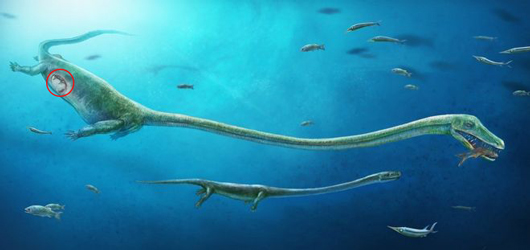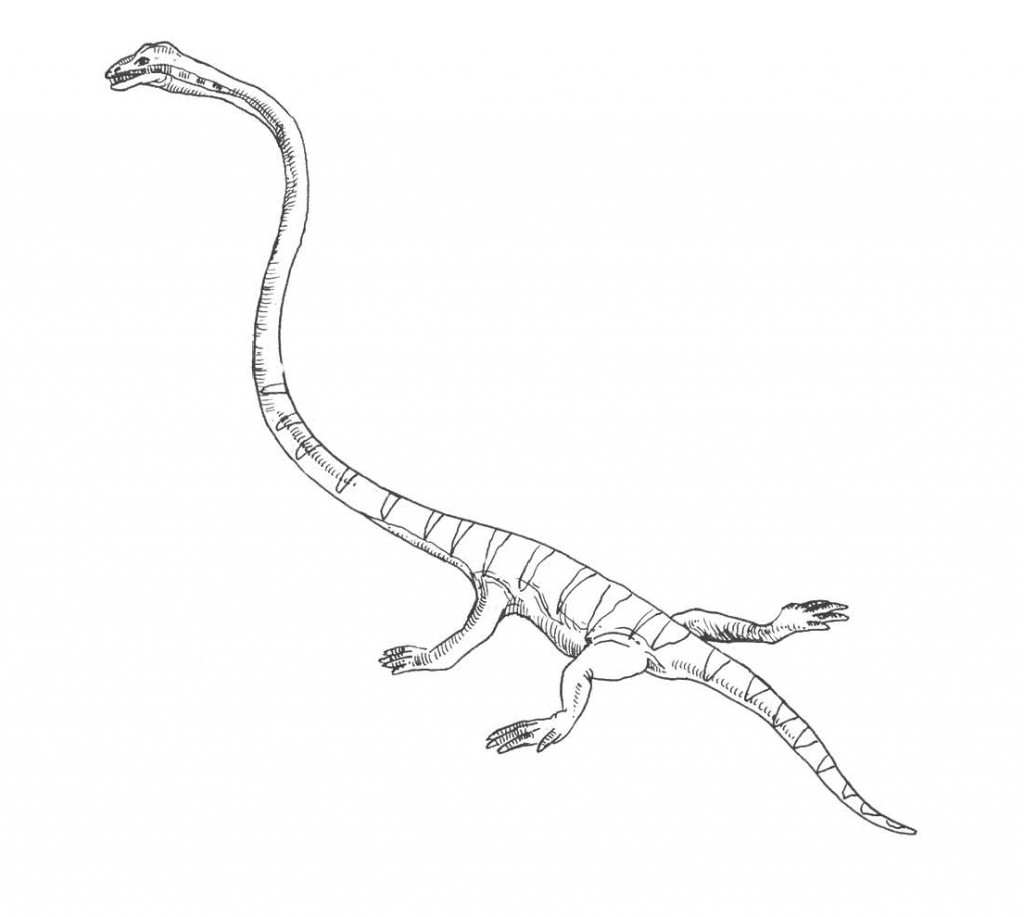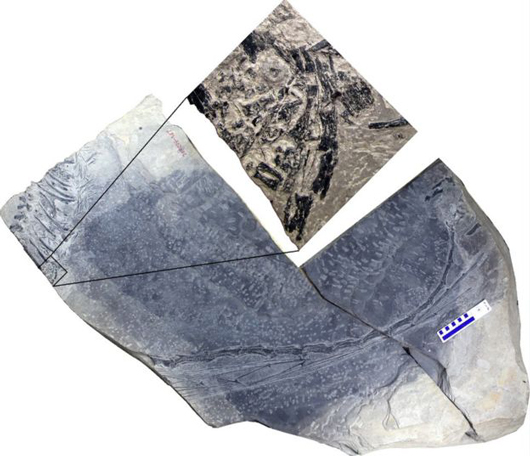First Live Birth Evidence in Ancient Dinosaur Relative
Dinocephalosaurus – The Only Known Viviparous Archosauromorph
The first ever evidence of live birth in an animal group previously thought to lay eggs exclusively has been discovered by an international team of scientists, including a palaeontologist from the University of Bristol. Writing in the academic journal “Nature Communications”, the researchers report upon the identification of a potential embryo inside the mother, a specimen of the long-necked archosauromorph Dinocephalosaurus (D. orientalis).
Dinocephalosaurus orientalis
Live birth (viviparity), is known in a number of extant reptiles, especially members of the Order Squamata, wherein a number of species of snakes and lizard “hatch” inside their mother and emerge without a shelled egg. However, this is the first time that live birth has been recorded in the Archosauromorpha, the infraclass of diapsid tetrapods that includes birds, crocodiles and dinosaurs.
An Illustration of the Long-Necked Marine Reptile Dinocephalosaurus (Location of Embryo Shown in Drawing)
Picture credit: Dinghua Yang with additional annotation by Everything Dinosaur
The picture above shows an illustration of the marine reptile Dinocephalosaurus. The approximate position of the embryo inside the mother is indicated by the red circle.
Egg Laying in Tetrapods
Egg laying is regarded by many scientists as a more primitive form of reproduction, seen at the base of reptiles, within the amphibious anamniotes and the ancestors of terrestrial vertebrates (fish). The fossil was found in 2008, at a quarry famous for marine fossils located in Yunnan Province (southern China).
Dinocephalosaurus was a long-necked, piscivore that flourished in warm, tropical, shallow sea that once covered much of China. Its fossils have been dated to the Middle Triassic. Dinocephalosaurus has been classified as a member of the Tanystropheidae family of archosauromorphs but how closely related it was to the better known Tanystropheus remains open to debate.
An Illustration of a Typical Member of the Tanystropheidae (Tanystropheus)
Picture credit: Everything Dinosaur
For models and replicas of prehistoric animals including archosauromorphs: Prehistoric Animal Figures and Models.
The Tanystropheidae Family
The Tanystropheidae family flourished during the Triassic and they were quite ecologically diverse. Most of the genera are associated with Tethys Ocean coastline deposits, although several species are associated with strata laid down inland. The scientists discovered the embryo inside the rib cage of the mother, and it faces forward making it less likely to have been consumed. Swallowed animals generally face backward because the predator swallows its prey head-first to help it go down its throat. Furthermore, the small reptile inside the mother is an example of the same species.
Lead study author, Professor Jun Liu from Hefei University of Technology (China), stated:
“We were so excited when we first saw this embryonic specimen several years ago, but we were not sure if the embryonic specimen is the last lunch of the mother or its unborn baby. Upon further preparation and closer inspection, we realised that something unusual has been discovered. Further evolutionary analysis reveals the first case of live birth in such a wide group containing birds, crocodilians, dinosaurs and the Pterosauria among others, and pushes back evidence of reproductive biology in the group by fifty million years.”
The Fossilised Remains Showing a Close View of the Embryo in the Rib Cage
Picture credit: Jun Lu
Implications of the Dinocephalosaurus Fossil for Other Members of the Archosauromorpha
Evolutionary analysis shows that this instance of live birth was also associated with genetic sex determination. Co-author of the scientific paper, Professor Chris Organ, (Montana State University) commented:
“Some reptiles today, such as crocodiles, determine the sex of their offspring by the temperature inside the nest. We identified that Dinocephalosaurus, a distant ancestor of crocodiles, determined the sex of its babies genetically, like mammals and birds.”
The researchers conclude that this specimen from Yunnan Province rewrites our understanding of the evolution of reproductive systems. Perhaps, some distant descendants of these reptiles also retained this reproductive strategy, with other archosauromorph members using live birth rather than external egg laying. Maybe some dinosaurs were viviparous.
Studying the Dinocephalosaurus Embryo
The embryo measures around fifty centimetres in length, when fully grown Dinocephalosaurus measured over three metres long (although about half of its entire body length was made up of that super-sized neck). It is possible, that the scientists have drawn the wrong conclusion. The animal, if it was a baby Dinocephalosaurus and not the fossil specimen’s last meal that “went down the wrong way”, may have been in an egg and the eggshell that once surrounded the embryo was not preserved during the fossilisation process.
That explanation cannot be completely ruled out, but Professor Benton explained that the embryo’s bones were very well developed, whilst all living archosauromorphs lay eggs very early in embryonic development.
Furthermore, the team suggest that Dinocephalosaurus’s long neck and other features of its anatomy indicate it could not have manoeuvred easily out of the water, meaning a reproductive strategy like that of turtles, which lay eggs on land before returning to the water, was probably not an option.
Professor Mike Benton (School of Earth Sciences, Bristol University), another co-author of the paper said:
“The analysis of the evolutionary position of the new specimens shows there is no fundamental reason why archosauromorphs could not have evolved live birth. This combination of live birth and genotypic sex determination seems to have been necessary for animals such as Dinocephalosaurus to become aquatic. It’s great to see such an important step forward in our understanding of the evolution of a major group coming from a chance fossil find in a Chinese field.”
A Need to Look Closely at Other Fossils
Professor Benton added that since we now know that no fundamental biological barrier to live births exists in the Archosauromorpha, palaeontologists would be “looking very closely” at other fossils. He suggested one target would be a group of aquatic crocodile relatives, whose mode of reproduction was not well known.
This piece of work is part of wider collaborations between palaeontologists in China, the United States, the UK and Australia.
The scientific paper: “Live birth in an Archosauromorph Reptile” by J. Liu, C. L. Organ, M. J. Benton, M. C. Brandley and J. C. Aitchison published in Nature Communications
Everything Dinosaur recognises the assistance of the University of Bristol in the compilation of this article.
Visit the award-winning Everything Dinosaur website: Everything Dinosaur.




